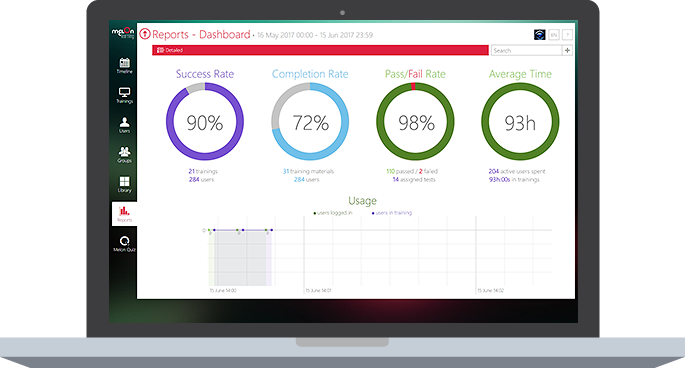Much has been said and written about the fact that training your employees improves their productivity and results in lower turnover rates, which in turn makes your organization more competitive affecting the bottom line in a positive way. But, as the person responsible for eLearning, how do you approach key decision makers with a solid proof that it works? Online training is not new, but perhaps not as many companies have used the full potential of the tools and methods available to measure its impact on profitability and the true power it has to make your business more competitive.
Let’s look at the 5 ways in which you can quantify the effect that online training has on profitability.
 #1 It’s an investment - measure the ROI
#1 It’s an investment - measure the ROI
When it comes to finance using vague terms such as ‘great’ or ‘exceptional’ to describe your investment won’t cut it in front of your stakeholders. You need to be able to measure the return you get on your money in order to justify the spending. So how do you calculate the ROI of training? Let’s use an example to illustrate it.
If you have a quantifiable target such as increased productivity as the result of a particular training, you can use a simple formula to calculate your ROI.
ROI% = (Benefits/Cost) x 100
The benefits is what you get as a result of your employees acquiring a new skill or knowledge for example. Let’s assume that there was increase in sales revenue of 100,000 Euro for the last quarter and an intensive training program took place the quarter before. Then we can assume that training helped your sales force achieve this result and as a consequence of your team being trained on a new product. So, if the investment in creating an online course was 5,000 Euro, then the ROI is 100,000/5,000 x 100 = 200% or in other words the benefits are worth four times the cost of implementation. Yes, we know it’s not as simple as that but usually when training is at the right time and the right place, it results directly in increased revenue.
Different approaches to calculate ROI from eLearning can be applied depending on the specifics of the company. Here is a good list of ROI calculators that you may use as a starting point to find your formula.
 #2 Increased Sales
#2 Increased Sales
It has been proven that eLearning has a direct impact on the way your sales team performs and of course a more informed sales force means more sales. Not only is online training a fast way to educate and inform but it also allows for instant feedback so you can determine where the gaps in knowledge and skills are. You can measure the overall impact of eLearning over time by focusing on sales conversions and cost per customer acquisition. The higher the former and lower the latter, the more certain you can be that online training is paying off.
 #3 More Competitive organizations
#3 More Competitive organizations
With modern methods of online education and training there are many more opportunities for organizations to stay ‘on top of the game’ and ahead of their competitors. It is well known that learning organizations are more successful than their competitors that do not embrace learning as a core human process. Measuring your market share and calculating the impact of eLearning on its growth is another way to prove that training is affecting your bottom line in beneficial way. To measure competitive advantage of the learning organization, companies usually use the Kirkpatrick Model for measuring the impact of training.
Another interesting reading on the subject is the Bersin by Deloitte High Impact Learning Organization model, developed few years ago. This article by Josh Bersin is a good example of how learning in general can drive competitive advantage.
“An organization’s ability to learn, and translate that learning into action rapidly, is the ultimate competitive advantage,” says former GE CEO Jack Welch.
 #4 Save money
#4 Save money
One of the greatest things about eLearning is that it doesn’t just make money for your company by helping you generate additional revenue and increase market share, but also by saving money. Compared to traditional training methods that require a lot of investment in travel, time away from the office, venue booking and organization, etc., eLearning has proven over time that it’s a real resource saver.
We would like to illustrate this with the example of one of our own clients - Vivacom, Bulgaria. A company with over 3000 employees, Vivacom wanted an efficient and time and cost effective solution to train employees and meet company objectives. Without going into too much detail, after implementing the Melon LMS, they were able to realize savings of over 75,000 Euro (for 5 years) in hall rental and trainers’ fees, and also recover 1,700 mandays with the additional bonus of cutting in half the staff time for training evaluation and administering tests.
 #5 More efficient
#5 More efficient
eLearning is much more dynamic and multidimensional than F2F training and the instructional possibilities offered by it are countless. The audience engagement is higher and this results in better retention and skills development.
And what’s even better is that eLearning can be reused when there is churn in the organization - for example if you have a 10% employee turnover rate and you need to train again and again newbies in the company, investing in eLearning pays off many times over compared to in-class training where you spend time and money for every new employee. So your cost savings and the impact on the bottom line are not just a ‘one time’ event, they are actually a sound and continuous investment in the future of your company.
Time to consider eTraining for your organization. Melon Learning guarantees personal approach to your needs. Try Melon LMS and see how it helps you with plenty of data to calculate your KPIs and ROI.

